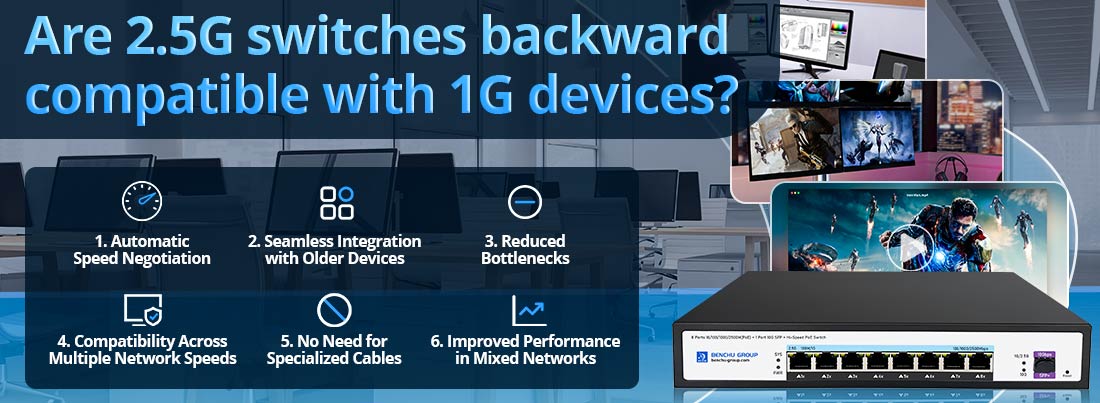
Yes, 2.5G switches are typically backward compatible with 1G devices. This means that if you connect a 1G (Gigabit) device to a 2.5G switch, the device will still function properly, but it will operate at its maximum supported speed, which is 1 Gbps. The switch automatically detects the speed capability of the connected device and adjusts the connection speed accordingly.
Here’s a detailed explanation of how backward compatibility works and what you can expect when using a 2.5G switch with 1G devices.
1. Automatic Speed Negotiation
--- 2.5G switches are designed to support multiple speeds, typically including 100 Mbps, 1 Gbps (Gigabit), and 2.5 Gbps. This is achieved through a feature called auto-negotiation, which allows the switch and the connected device to determine the highest supported speed for the connection.
--- When a 1G device is connected to a 2.5G switch, the switch detects that the device only supports 1 Gbps and establishes the connection at that speed. If you later connect a 2.5G-capable device to the same switch, it will automatically upgrade the connection to 2.5 Gbps.
Example: If you connect a gaming PC with a 1G Ethernet port and a NAS system with a 2.5G port to the same 2.5G switch, the gaming PC will connect at 1 Gbps, while the NAS system will connect at 2.5 Gbps.
2. Seamless Integration with Older Devices
--- Backward compatibility ensures that you don’t have to upgrade all your devices at once to enjoy the benefits of a 2.5G network. You can continue using your existing 1G devices (such as older laptops, desktop computers, or printers) while also introducing newer devices that support 2.5G speeds.
--- This means that as you gradually upgrade to devices that support 2.5G (such as newer gaming PCs, Wi-Fi 6 access points, or high-speed NAS systems), you can still use your old 1G devices without any issues. The switch will handle both types of connections efficiently.
Example: A home network with a 2.5G switch might have a mix of 1G smart TVs, 100 Mbps IP cameras, and a 2.5G gaming PC. The switch will allow all these devices to communicate at their maximum supported speeds without needing any manual configuration.
3. Reduced Bottlenecks
--- Even though 1G devices will still operate at their native speeds (1 Gbps), using a 2.5G switch can help reduce bottlenecks in your network, especially when multiple devices are active simultaneously.
--- For instance, if you have several 1G devices connected to the switch alongside a 2.5G device, the 2.5G switch ensures that each device gets the necessary bandwidth without overwhelming the network. This can improve overall performance compared to using a standard 1G switch, especially in scenarios with multiple high-bandwidth activities such as gaming, video streaming, or file transfers.
Example: If you’re transferring large files from a 2.5G NAS while streaming on a 1G smart TV and browsing the web on a 1G laptop, the 2.5G switch will efficiently manage the data flow to prevent congestion and ensure that each device gets the bandwidth it needs.
4. Compatibility Across Multiple Network Speeds
--- In addition to supporting 1G and 2.5G speeds, many 2.5G switches also support 100 Mbps devices, allowing you to connect even older network equipment without issues. The switch automatically steps down to the appropriate speed based on the connected device's capabilities.
--- This multi-speed compatibility ensures that a wide range of devices can be connected to the same network, from legacy 100 Mbps devices to modern 2.5G and beyond.
Example: If you have a mix of devices like IP cameras that run at 100 Mbps, 1G smart appliances, and 2.5G NAS devices, a 2.5G switch will automatically handle the appropriate speeds for each device.
5. No Need for Specialized Cables
--- 2.5G switches are also backward compatible in terms of cabling. They work with standard Cat 5e and Cat 6 Ethernet cables, which are commonly used for 1G networks. This means you don’t have to replace your existing Ethernet cables to benefit from 2.5G speeds unless you’re using very old Cat 5 cables.
--- Cat 5e cables can handle speeds up to 2.5 Gbps over distances up to 100 meters, so if your home or office is already wired with Cat 5e or Cat 6, you can easily upgrade to a 2.5G switch without additional cabling costs.
Example: If your home is wired with Cat 5e cables, you can upgrade to a 2.5G switch without replacing the cables, and both your 1G devices and 2.5G devices will work without issue.
6. Improved Performance in Mixed Networks
--- Even though 1G devices are backward compatible, upgrading to a 2.5G switch can improve the overall performance of your network by freeing up bandwidth for 1G devices when paired with 2.5G or higher-speed devices.
--- If you’re transferring data between a 2.5G-capable NAS and a 1G PC, the 2.5G switch ensures that the NAS can take full advantage of its higher speeds when communicating with other 2.5G devices, while maintaining stable 1G connections to older devices. This leads to better performance for tasks like streaming, gaming, or file transfers, even on a network with mixed-speed devices.
Example: In a small business setting, a 2.5G switch could connect 1G office PCs and 2.5G file servers. The 1G PCs won’t be slowed down by the 2.5G devices, and overall network performance will improve.
Conclusion:
A 2.5G switch is fully backward compatible with 1G and even 100 Mbps devices, thanks to automatic speed negotiation. This allows you to connect older 1G devices to a 2.5G switch, where they will operate at their maximum supported speeds (1 Gbps), while newer, faster devices can take advantage of the 2.5 Gbps speeds.
By upgrading to a 2.5G switch, you can future-proof your network, improve overall performance, and manage high-bandwidth tasks more efficiently, all while continuing to use your 1G devices without disruption or compatibility issues.